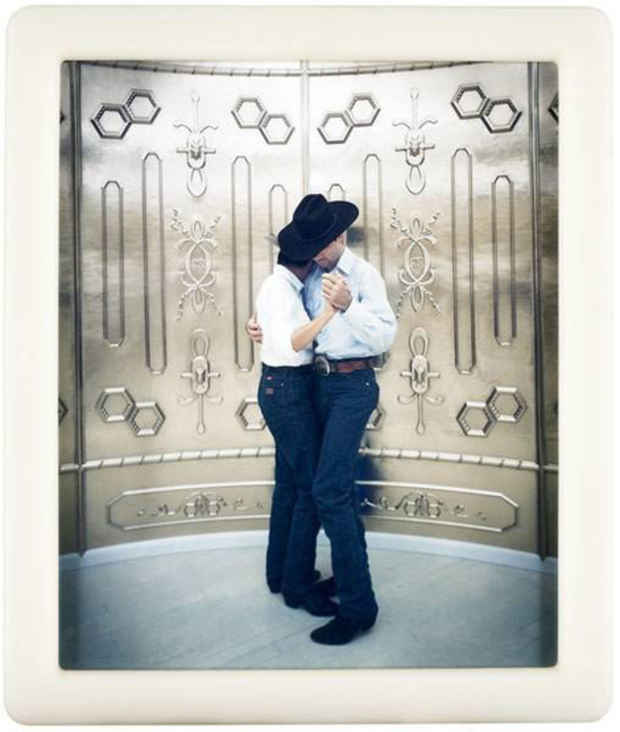"Melodymania" Exhibition
RH Gallery

This event has ended.
The term, Melodymania, denotes the common experience of having a song stuck in your head. This experience is projected into artworks that emanate music, even in their silence. Throughout the works in this exhibition, we encounter the omnipresence and power of music. The work produces new perspectives and meanings that unfold to represent music anew in subtle and surprising ways.
Newsha Tavakolian recently completed a series of portraits entitled Listen which captures Persian female singers who have been banned from performing in public or producing albums in Iran. Tavakolian has given them voice through her photographs depicting them solemnly singing. The specter of their voices is revealed in absentia. A portrait of Kurt Cobain by Mark Seliger, included in the exhibition, depicts the tone of his music in his expression. As does the portrait of Bob Dylan by Elliott Landy.
Soledad Arias presents a neon work scripting the word “lullaby.” From the text and its form, a lullaby and all relevant associations are insinuated without song or voice. Additionally, the inclusion of brackets is endemic to Arias’ meditative play on language: a lullaby is soft and understated like text in brackets. Also included is a print depicting the sound wave of Arias speaking the word “lullaby”.
In Bruce Nauman’s print Violins/Violence, the artist is also dealing with language, a trope threading through his entire oeuvre. In Violins/Violence, he creates a pun that is simultaneously verbal, visual, and aural. It describes and conjures a particular sound produced by violins, enhanced by his sharply scratched drypoint lines.
Mathew Barney’s photograph The Executioner’s Song originated from his film Cremaster 2, loosely based on Norman Mailer’s The Executioners' Song. Mailer’s book chronicles Gary Gilmore, a convicted killer and the alleged grandson of Harry Houdini. The scene depicted in Barney’s reiteration is set during Gilmore's metaphoric transportation back to the turn of the century, rendered in a dance sequence featuring the Texas two-step. Barney commissioned an original score for the film and the music plays an integral role in setting the tone as well as narrating the story. In the photograph, even without the music, one can sense the rhythm and the sound. The music has been translated into visual elements; it has been constructed within the image.
Yi Zhou also makes videos in which music plays an integral role to shape content and determine pace. Ennio Morricone, widely acknowledged as one of the most prolific and influential composers of his era, wrote the music for Yi Zhou’s recent video, Labyrinth. Rather than matching a score with a film, the imagery of the film appears to follow the score. A prominently-featured Buddha-like figure covers its ears as if to escape the music and perhaps in turn, the unfolding apocalyptic sequence. In other words, the music plays protagonist.
Panni Malekzadeh will be making a new work for this exhibition. Her practice juxtaposes contradicting imagery in a process that plays with collaged compositions within painting. Her subject matter is a personal exploration of femininity, vulnerability, fantasy and violence. Panni often integrates text into her work borrowed from her contemporary environment.
The exhibition also includes a painting by Slater Bradley titled The Sun Ain’t Gonna Shine No More, a work from a series Bradley made in 2009 inspired by Joy Division and the sentimental ephemera produced by their fans. Mickalene Thomas also often uses song lyrics or album titles for the titles of her works. Thomas’ imagery is largely inspired by certain musicians and the culture that grew around them such as Eartha Kitt, Betty Davis, Donna Summer and Whitney Houston. In an interview in Art In America, Madison Moore wrote “It's almost like I can hear soul music when I look at your work.”
Atsushi Fukui, Wolfgang Ellenrieder and Yoshitomo Nara are inspired by environments characterized by music. Ellenrieder’s large painting of a disco ball portrays a kind of stage for music while Fukui imagines an fantastical landscape populated by a sole guitar player. Nara’s inventive characters are often immersed in music in one way or another. Much of his work is inspired by his deep appreciation for punk music and the culture it produced.
Media
Schedule
from September 14, 2011 to October 29, 2011
Opening Reception on 2011-09-13 from 19:00 to 21:00